Posts Tagged ‘how do I know I have ice dams’
Friday, February 3rd, 2017
The Relationship Between Ice Dams and Icicles
Do Icicles Mean Ice Dams?
You may notice that the home shown below has some icicles (sarcasm intended). Obviously, when something like this occurs, it is quite likely that you have ice dams as well as a giant insurance claim from the subsequent water damage it has caused. The fact is, the vast majority of the ice dam steaming projects we complete are not on homes with monster icicles. When we arrive we often see quite modest icicles from the ground. The relationship between icicles and ice dams is not difficult to understand when you study the problem for awhile. This Case Study digs into the topic of icicles and ice dam life cycles.
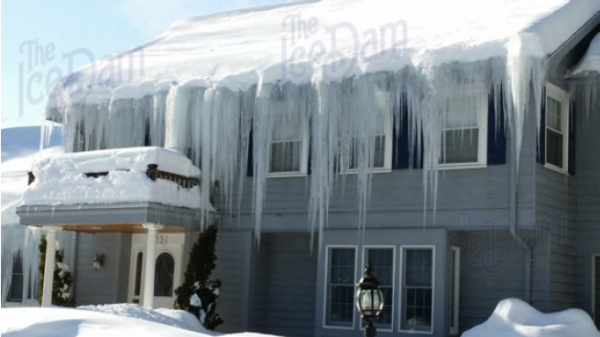
Do icicles mean ice dams? The short answer is NO. While icicles on the edge of the roof are often a precursor to ice dams, they are not always present when ice dams begin to cause leaks through a roof system. Ice dams and icicles are part of the same accumulation but they are not the same thing by any means. This brings us to the normal life cycle of an ice dam.
The characteristics of ice dams change over time. The typical lifespan of an ice dam rangers from a few days to a few weeks. During that time it may get thicker or thinner, icicles may appear and disappear on its’ leading edge, and it may be almost completely hidden under snow or partially or completely exposed. For this reason, there is a big different between a young ice dam and an old ice dam in terms of the presence of icicles. Very young ice dams often have visible icicles on their leading edge. Over the following days most ice dams tend to grow more in depth than thickness, meaning the ice migrates higher up on the roof plane (refer to Case Study #06 for more information). Icicles on more mature ice dams tend to melt away from the affects of direct sunlight or warmer outdoor temperatures. However, while the telltale icicles may be missing, the mass of the ice dam is left behind, frequently hidden under a blanket of snow.

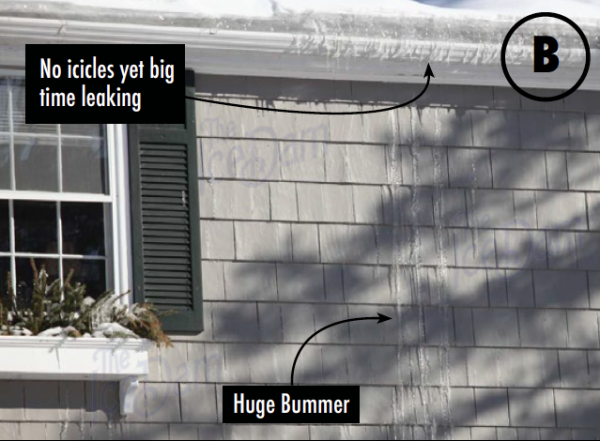
The photos above (A) and (B) demonstrate this phenomenon on two St. Louis Park homes. Virtually no traditional signs of an ice dam and yet you see water leaking down the exterior wall, through the siding and in the wall cavity itself. Bad news.
Case Study #16 examines the important topic of ice migration, from icicles to the interior of your home.
To read more Case Studies click here.
Tags: about ice dams, best ice dam removal in minneapolis, best rated ice dam removal contractor, edina ice dam removal, highest rated ice dam removal company in minneapolis, how do I know I have ice dams, how to file an insurance claim for an ice dam, ice and snow removal, ice dam expert, ice dam heat cable, Ice dam heat tape, ice dam prevention, Ice dam removal, ice dam removal jerks, minneapolis ice dam removal, twin cities ice dam remover, wayzata ice dam removal
Posted in Ice Dam Heat Tape, Ice Dam Prevention, Ice Dam Removal, Ice Dams, Misc., Ice Dams: General Info, Water Damage | Comments Off on Icicles and Ice Dams
Tuesday, December 20th, 2016
The Relationship Between Sunshine and Ice Dam Formation
Ice dams happen when there is a section of roof that is above freezing (32°) where roof snow melts which then drains to an area that is below freezing, usually the eaves, where it refreezes. The source of this temperature differential is usually the result of interior heat loss, specifically via air leaks and insulation issues. In fact, according to our experience, 95% of our client’s ice dam problems can be mitigated or eliminated altogether through the modification of the thermal characteristics of the home. Still, we see ice dams on certain homes for reasons outside the scope of it’s architectural deficiencies. Homes with what we might call nearly perfect air-sealing, insulation and ventilation still get ice dams. This Case Study describes such a situation.
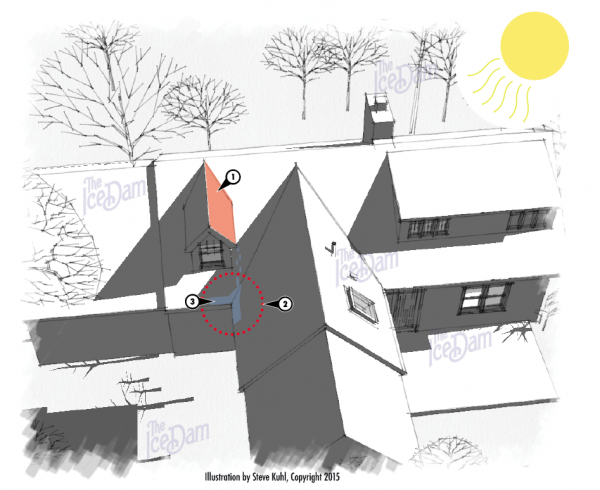
The winter sun hits Minnesota homes (and all homes in this latitude) at a low angle during the winter. The result is that certain roof slopes never see direct sunlight while others get hit quite directly. The above illustration demonstrates an ice dam situation that relates to the heating effects of the sun. Solar radiation warms the roof slope on the dormer (1), the resulting melt water drains to an area of the home (2) that never sees direct sunshine where it refreezes to form an ice dam (3). These are particularly challenging ice dams to prevent. Often times heat tape, also known as heat cables, are the only affordable option.
To read more Case Studies click here.
Tags: about ice dams, best ice dam removal in minneapolis, best rated ice dam removal contractor, edina ice dam removal, edina ice dam steaming, highest rated ice dam removal company in minneapolis, how do I know I have ice dams, ice and snow removal, ice dam expert, ice dam heat cable, Ice dam heat tape, ice dam prevention, ice dam removal jerks, minneapolis ice dam removal, sunshine and ice dams, thermal characteristics and ice dam prevention, thermal imaging and ice dam identification, thermal inspection, twin cities ice dam remover, wayzata ice dam removal
Posted in Ice Dam Prevention, Ice Dams, Misc., Ice Dams: General Info | Comments Off on Sun and Ice Dams: Cause and Effect
Thursday, December 15th, 2016
A Simple Explanation of Where the Water Goes When Ice Dams Cause Leaks
Where the Water Travels:
Water hitting the Top Plate of the wall (A) spreads out across the top plate, travels downward with gravity, working behind the Siding (B) the Housewrap (C), the Insulation (D), the Vapor Barrier (E) and the Drywall (F). Water always seeks the path of least resistance and therefore frequently shows up through existing penetrations in the ceiling such as lights. Water leaks caused by ice dams can travel many feet from the source before manifesting inside the home. On homes built with vapor barriers on top of the ceiling finish, water will sit on top of the drywall and soak the insulation before leaking inside.
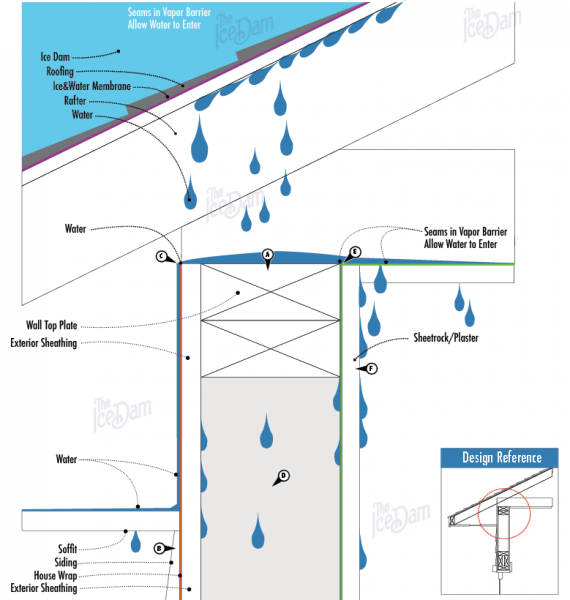
To read more Case Studies click here.
Tags: about ice dams, best ice dam removal in minneapolis, best rated ice dam removal contractor, edina ice dam removal, edina ice dam steaming, heat tape, heat tape ice dam, heat tape ice dam prevention, highest rated ice dam removal company in minneapolis, how do I know I have ice dams, how to tell if an ice dam is a problem, ice and snow removal, ice dam heat cable, orono ice dam removal, twin cities ice dam remover, wayzata ice dam removal
Posted in Ice Dams, Misc., Ice Dams: General Info | Comments Off on Close Up of an Ice Dam Leak
Thursday, December 8th, 2016
How Roof Pitch (Roof Slope) Affects the Impact of Ice Dams on Standard Residential Construction
Fact: The Flatter the Roof, the Less Ice it Takes to Cause Problems
As discussed in previous Ice Dam Company blogs and Case Studies, there is a strong relationship between roof slope and the timing and likelihood of damage as the result of ice dams. Specifically, low roof slope areas are far more susceptible to damage by small ice accumulations than areas of steeper slope. Why? It comes down to basic geometry. Study the diagrams, below. You can see that the high slope roofs (C) require a pretty thick ice dam to form before water will begin leaking into the home. Eave depth plays another important role. See Case Study #10 for more information.
Ice dams create leaks when melted water from higher on the roof slope hits a dam of ice and is forced to travel backwards, up and under the plus of the roofing system (typically asphalt shingles). When that backward motion occurs outside the plane of exterior wall (dotted red lines in diagrams), the water runs down the exterior wall or through the soffits (zone indicated by happy face). As soon as the water falls on top of the top plate of the wall it seeps down through the wall causing damage to insulation, finishes and flooring (zone indicated by sad face). Truthfully, water coming through your soffits is nothing to be happy about. The next step is the interior of your home so it is considered an emergency in terms of the progression of the ice dam. As mentioned before, if you see ice coming through the soffit or down the exterior wall, it’s time to get that ice dam removed.

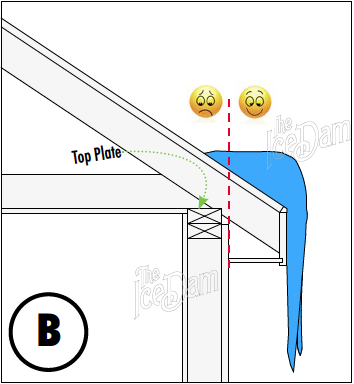
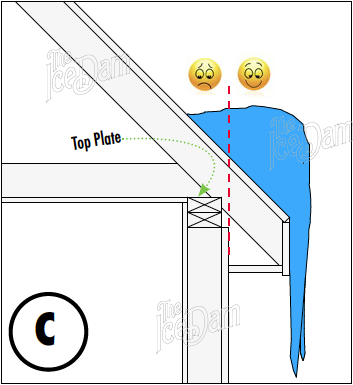
Wayzata Residence with Low Pitch Roof Suffers the Consequence
Seen below is a home in Wayzata, Minnesota where we steamed an ice dam a couple of years ago. The construction assembly was typical 2×6 walls, 12″ eaves, 6″ facia with a 2/12 roof pitch. From the ground, no ominous, threatening icicles could be seen, just a couple of pathetic whiskers of ice off the face of the gutter through the soffit (D). Pan out and you see that the entire exterior wall was bleeding ice through the siding. This is bad. This home had massive damage to the interior insulation, drywall and flooring systems.

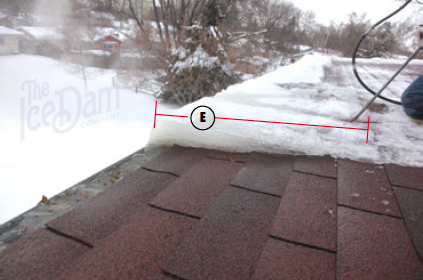
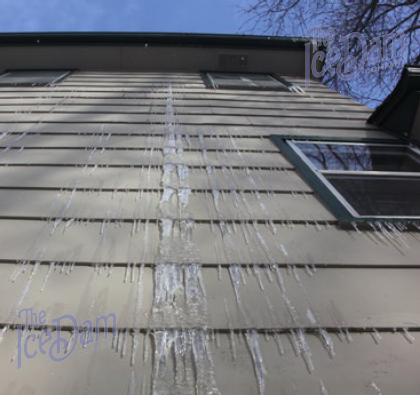
As discussed in Case Study #06, low pitch roofs also tend to create ‘deeper’ ice dams (E), where the ice has grown further up the roof. Deep ice dams take far longer to remove.
Three take-aways:
- No icicles does not mean no ice dams.
- Low pitch roofs present higher risks in terms of how quickly small ice dams can cause big problems.
- Ice or water coming down the exterior wall in below freezing conditions is bad. Very, very bad.
To read more Case Studies click here.
Tags: about ice dams, best ice dam removal in minneapolis, best rated ice dam removal contractor, commercial ice removal, edina ice dam removal, edina ice dam steaming, highest rated ice dam removal company in minneapolis, how do I know I have ice dams, ice and snow removal, ice dam expert, ice dam heat cable, ice dam prevention, ice dam removal jerks, twin cities ice dam remover, wayzata ice dam removal
Posted in Ice Dam Prevention, Ice Dam Removal, Ice Dams, Misc., Ice Dams: General Info, Water Damage | Comments Off on Roof Pitch and Ice Dams: Part 1
Monday, December 5th, 2016
1. Water Damage
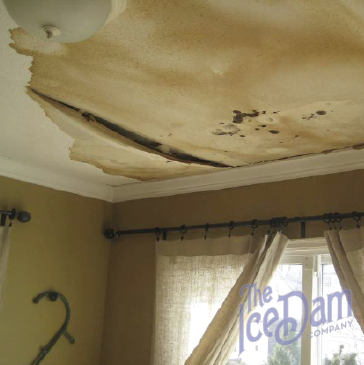
2. Ruined Insulation
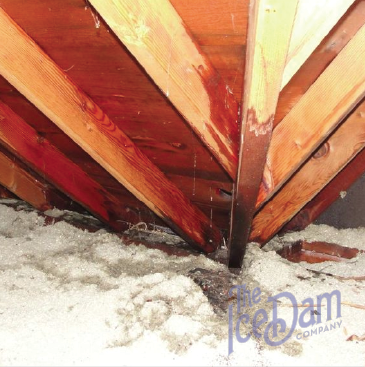
3. Mold and Mildew
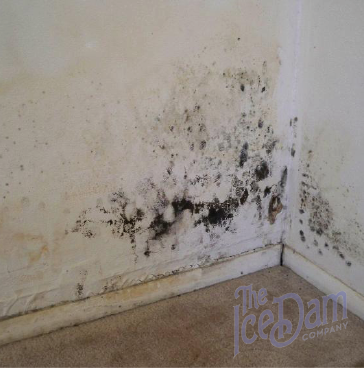
4. Gutter Damage
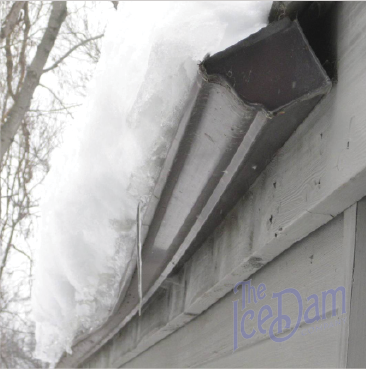
5. Property Damage
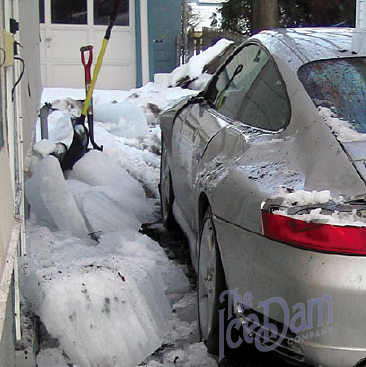
6. Soffit Damage
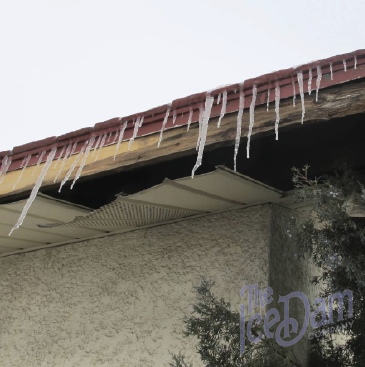
7. Landscaping Damage

8. Falling Ice
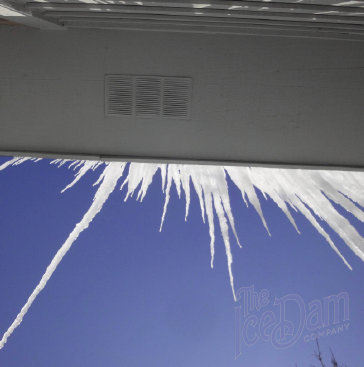
9. Flooring Damage
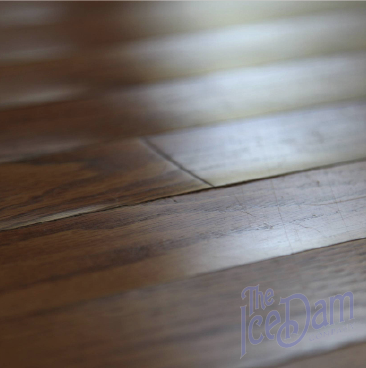
To read more Case Studies click here.
Tags: about ice dams, best ice dam removal in minneapolis, best rated ice dam removal contractor, commercial ice removal, edina ice dam removal, edina ice dam steaming, gutter deicing wire, highest rated ice dam removal company in minneapolis, how do I know I have ice dams, how to file an insurance claim for an ice dam, ice and snow removal, ice dam expert, ice dam removal jerks, minneapolis ice dam removal, orono ice dam removal, roof ice steaming, twin cities ice dam remover, wayzata ice dam removal
Posted in Ice Dam Prevention, Ice Dam Removal, Ice Dams, Misc., Ice Dams: General Info, Water Damage | Comments Off on 9 Common Types of Ice Dam Damage
Tuesday, November 15th, 2016
The Fundamental Underlying Cause of Most Ice Dams
We have spent a lot of time discussing the finer points about ice dams over the years. This Case Study is about pulling the focus back to the most global understanding of why ice dams happen.
What Causes Ice Dams
There are over a dozen factors that contribute to the formation of ice dams, all of which have been discussed in previous Case Studies. Fundamentally, only one condition MUST be met in order for ice dams to form: A temperature differential from one area of a roof assembly to another area, with the upper area being above 32° and the lower area being below 32°. See below.
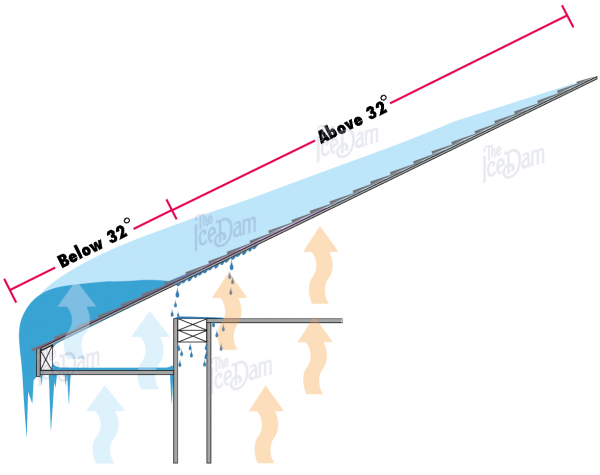
How it Works
This diagram demonstrates the basic concept behind ice dam formation. Snow melts in the area above 32°, water runs down to the area below 32° and refreezes. This cycle continues until an accumulation of ice forms that is large enough to block water from flowing naturally off the roof. The resulting ‘ice dam’ forces water to back up under the roofing materials and into the structure. There are many intersecting variables that cause the phenomenon described here. See below.
List of 7 Contributing Factors to Ice Dam Formation
- A period of outdoor temperatures ranging between 0°-10° at night followed by daytime temperatures between 10°-20°.
- Repeated snow falls that keep the roof loaded with new snow resulting in at least 6″ of coverage at all times.
- Thermal inefficiencies in the home that allow warmth to heat up the roof deck from the underside.
- Homeowner lifestyle that results in excessively heated spaces (More heat equals more roof snow melting).
- Roof pitch: Flatter roof pitches tend to be more affected by problematic ice dams.
- Eave depth: Smaller eaves tend to be more affected by problematic ice dams than deeper eaves.
- Age and construction style of home: Older homes tend to be more affected than newer homes.
To read more Case Studies click here.
Tags: about ice dams, best ice dam removal in minneapolis, best rated ice dam removal contractor, highest rated ice dam removal company in minneapolis, how do I know I have ice dams, how to tell if an ice dam is a problem, ice and snow removal, ice dam heat cable, ice dam prevention, Ice dam removal, ice dam removal jerks, twin cities ice dam remover
Posted in Ice Dams, Misc., Ice Dams: General Info | Comments Off on What Causes Ice Dams
Saturday, October 15th, 2016
How the Distribution of Snow Can Affect the Formation of Ice Dams
Snow and Ice Dams
There is a complex relationship between snow and ice dams. Yes, you need snow to get ice dams. Snow is, after all, the fuel that feeds the formation and growth of ice dams. Furthermore, it is unlikely to get ice dams unless there is an ongoing layer of snow on your roof over a period of time (normally at least 7-10 days). But it takes more than just having snow on your roof to get ice dams. See Ice Dam Company Case Study #23 for a list of contributing factors. One factor that seldom gets discussed is the affect of wind on the formation and severity of ice dams. While this is not a primary factor, it is something worth exploring. This Ice Dam Case Study looks at the affect a thinning snow cover has when seen on a roof slope that also faces the sun. The affect described below is exacerbated by the presence of darker roofing materials as they absorb more solar energy than lighter materials.
Mountains and Roofs Share Something in Common
Any skiers out there? Wind speeds increase near the ridge of a roof just like the top of a mountain. Snow on one side of the ridge is often swept away while remaining in place just on the other side of the peak. This phenomenon can affect both sides of a roof if wind direction changes from day to day, leaving the snow coverage thin or non-existent on the upper few feet of the roof below the ridge.
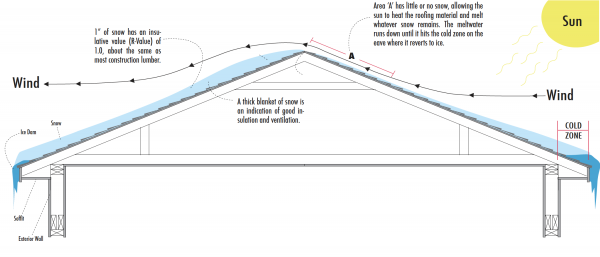
Condensation, The Silent Killer
The lack of an insulating snow blanket can allow heat from the inside of the home to meet cold exterior air in a thinner ‘conduction plane’. When heat hits a thin surface such as a roof decking, where there is a great temperature differential from one side to the other, condensation is also likely. Think of frost on old, single paned windows. The more space there is between the heat and cold, the more room there is for this interaction, greatly reducing the likelihood of condensation. A thick blanket of snow is a perfect insulator for this purpose. It creates more separation between the warmth being lost from the home and the frigid exterior air. Homes with thick snow coverage on their roofs generally seen as more efficient because heat is not escaping through the roofline to reduce the snow through melting.
To read more Case Studies click here.
Tags: about ice dams, best ice dam removal in minneapolis, best rated ice dam removal contractor, highest rated ice dam removal company in minneapolis, how do I know I have ice dams, how to tell if an ice dam is a problem, ice and snow removal, ice dam expert, ice dam removal jerks, ice removal company, minneapolis ie dam removal, steamer
Posted in Ice Dams, Misc., Ice Dams: General Info | Comments Off on Snow Distribution and Ice Dams
Saturday, October 1st, 2016
There is a lot of misinformation out there on the topic of ice dams. Our goal here is to be the single definitive source for all things relating to ice dams. Towards that end, here are some common misconceptions about ice dams, roof snow, roof ice and gutter ice removal.
FACT: Ice dams can occur with virtually no snow on your roof. It’s a question of ice accumulations. It takes very little actual moisture to form ice dams. Even a dusting of snow can create a problem. Of course it is most often the case the thick snow accumulations create ice dams more quickly, but don’t be fooled into complacency because it’s a low snow season. See Case Study #09.
FICTION: Gutters have something to do with ice dams. The truth is gutters have nothing whatsoever to do with ice dams. See Case Study #03 for proof. If your home is prone to ice dams you will get them regardless of whether or not you have gutters. If you have gutters they will fill with ice and provide a foundation for the ice dam above. True. If you don’t have gutters, the ice dam simply builds on the cold edge of the roof. We provide ice dam removal for many homes each year that do not have gutters. In fact, some of our repeat clients have removed their gutters upon the advice of a dumb person only to be shocked that the ice dams came back the season after. Whoops.
FACT: Gutter systems can be damaged by ice. We see it every year. A section of otherwise fine gutter is either on the ground or hanging pathetically off the edge of the roof, filled with ice. Ice weighs about 60 pounds per cubic foot and gutters are not designed to tolerate that sort of load. It’s important to initiate gutter ice removal sooner than later for this reason. See Case Study #11 for common ice dam damage.
FICTION: When it comes to insulation, the more the better. Improperly insulated homes are just as bad as under insulated homes when it comes to ice dams. We have fixed countless bad insulation jobs for this reason. Specifically, we frequently find insulation done in such a way as to inhibit proper ventilation. Moreover, if you don’t address air leakage into the attic or rafter spaces, all the insulation in the world won’t prevent ice dams. See Case Study #04 for details about good eave ventilation.
FACT: You can’t always see ice dams from the ground. It’s true that you can often spot a monster ice dam quite quickly. It’s easy to spot the two foot icicles and the little adjoining glacier on your gutter. The sneaky ones are usually above skylights or in roof pan areas far out of sight. Sometimes ice dams grow up valleys and on top of dormers making it almost impossible to identify from the ground. See Case Study #02 for more information on where ice dams form on residential homes.
FICTION: Salt socks are a smart way to address ice dams. People use pantyhose, old socks and store-bought cloth tubes filled with a variety of ice-melting compounds for removing ice dams. Corrosive substances like rock salt, sodium chloride, calcium chloride, magnesium chloride and more to melt channels through their ice dams. Some compounds are better than others, but all present risks you should keep in mind. Some of the aforementioned chemicals affect the integrity or color of your roof, some are corrosive to the aluminum when gutter ice is removed this way, some are corrosive to valley metal and other flashings, some damage plant life as the water drains below. You are rolling the dice when you go this route so be aware. See Case Study #13 for more information on salt socks (salt in pantyhose).
FACT: Ice should be removed by steam. Here is the skinny. We are roofers and have fixed hundreds of roofs that have been damaged by well-intentioned professionals with hammers, picks and hatchets in their pursuit of removing ice dams to help their clients. The damage we have found caused by the less-than-professional souls is almost funny if it wasn’t so serious. In our years we have seen jobs with picks and hammers where removing ice dams was done successfully. It get’s down to the question of whether you want to take that risk? We strongly advise against the hack-a-teer approach even if it is a little cheaper. Roof Ice and Gutter Ice should always be removed with steam.
FICTION: Ice dams need to be thick to cause a problem. Ice dams as thin as one inch can cause big problems. A good general rule is that the steeper your roof, the thicker the ice dam has to be to cause problems. On lower pitched roofs even a thin ice dam can hurt.
FACT: The leaking caused by ice dams may not show up right away. It would be nice if water stains or mold manifested immediately upon entering your home but it simply does not work that way. Often the water that ice dams push into homes travels around wall and ceiling cavities, trapped by vapor barriers and other materials until it finds the path of least resistance to escape. By the time you see water inside, it’s usually been there for a while, which results in mold and mildew.
To read more Case Studies click here.
Tags: about ice dams, best ice dam removal in minneapolis, best rated ice dam removal contractor, commercial ice removal, edina ice dam removal, edina ice dam steaming, gutter deicing wire, highest rated ice dam removal company in minneapolis, how do I know I have ice dams, ice and snow removal, ice dam expert, ice removal professionals, minneapolis ice dam removal, twin cities ice dam remover
Posted in Ice Dam Prevention, Ice Dam Removal, Ice Dams, Misc., Ice Dams: General Info, Water Damage | Comments Off on 10 Ice Dam Facts: Ice Dam Myths Explored
Wednesday, June 22nd, 2016
The Truth About Gutters and their Relationship with Ice Dams
In 2011, Ice Dam Company owner Steve Kuhl wrote a nationally published article about ice dams for the Journal of Light Construction. One of the topics that receieved the most attention was the notion that gutters have nothing to do with ice dams. Here is a deeper look at that assertion.
There is a great deal of confusion and misinformation about the relationship between gutters and ice dams. Many people are under the misconception that gutters cause ice dams or that gutters filled with ice can cause water to back up into homes. Not true. We repeat. Gutters have nothing to do with ice dam formation or severity. For this reason, buying systems that heat gutters in order to prevent ice dams is a total and complete waste of money.
We know that ice dams occure when:
- Escaped heat from the inside of the home warms the roof deck.
- Melting snow results in water that runs down to a cold, unheated area of the roof (frequently the eave, as shown below).
- That water freezes, forming ice. After many of these cycles, that ice piles up to form an ice dam.
Study the illustrations below. These are identical eave designs, one with gutters, the other without. The Area B in the diagrams below is referred to as the ‘cold edge’ of the eave because heat from the interior of the home doesn’t travel that far. Fact One: Whether or not a home has gutters, a cold edge will still exist and this is where ice dams form. Fact Two: leaks from ice dams occur in Area A, at the leading, top edge of the ice dam where water–with nowhere else to go–is forced up under the roofing material and into the home. Put another way, if the home in Figure 2 had bad leaks inside, those leaks would not be eliminated whatsoever if we took a chainsaw and cut off the gutters along the red dashed line (C). Moreover, if we heated the gutters using a fancy electrical system, the likelihood of ice dams and the subsequent leaking would NOT be affected. Spend money on heat cables for the lower edge of your roof, not on heating the gutters only. High quality heat cables can be quite effective in preventing ice dams.
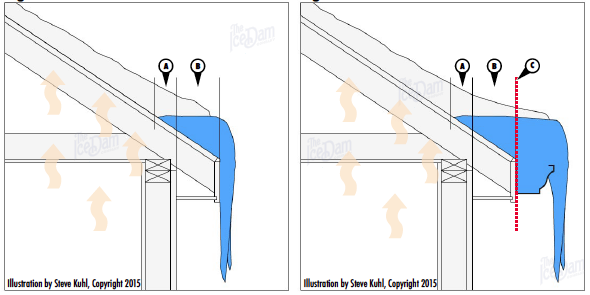
Figure 1: Ice Dam Without Gutters; Figure 2: Ice Dam With Gutters
None of this is to suggest that ice in gutters are harmless. We have seen many gutters damaged or destroyed by ice dams and that is a problem most homeowners would like to avoid. The point here is that, all else held equal, if a home is likely to get ice dams the addition or deletion of gutters will be of no consequence to the formation or severity of said ice dams. Likewise, for this reason, installing heated gutters or adding heating systems to existing gutters will have no affect whatsoever on the occurrence or severity of ice dams.
To read more Case Studies click here.
Tags: about ice dams, best ice dam removal in minneapolis, best rated ice dam removal contractor, commercial ice removal, edina ice dam removal, highest rated ice dam removal company in minneapolis, how do I know I have ice dams, how to tell if an ice dam is a problem, ice dam expert, ice dam removal jerks, identifying an ice dam, minneapolis ice dam removal
Posted in Ice Dam Heat Tape, Ice Dam Prevention, Ice Dam Removal, Ice Dams, Misc., Ice Dams: General Info | Comments Off on Ice Dams in Gutters: A Myth in the Making
Friday, May 20th, 2016
Where Do Ice Dams Normally Happen on Homes? A List of the Most Common Ice Dam Locations
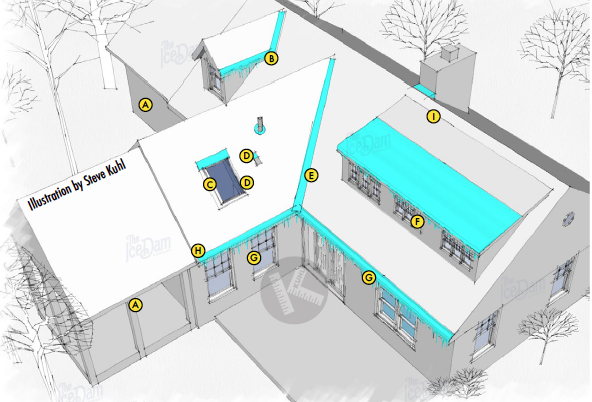
Where ice dams happen…and don’t happen:
- Ice dams seldom occur over unheated areas such as garages and porches (A).
- The valley areas of dormers frequently get ice dams (B).
- Ice dams often occur both below and above skylights. Ice dams above skylights are hard to see from the ground, making them some of the sneakiest to discover (C).
- Any openings through the roof – such as pipes and vents – are a good place for small ice dams for form (D).
- Valleys are very common areas for ice dam formation. It is important to never use hammers or chisels near valleys as the difference between a thorough ice removal job and valley damage is fractions of an inch (E).
- On roofs with a low pitch (angle) even a 1-2″ ice dam can cause significant leaking and interior damage (F).
- The eaves edge is the most common place to see ice dams. 80% of the dams we remove are found here (G).
- Interior rooms with vaulted ceilings are frequently associated with large ice dams. Bathrooms are often the worst. If you had recessed lighting to a vaulted ceiling, you are much more likely to have ice dams (H).
- Ice dams occasionally form around chimneys and furnace flues. Any place heat escapes through the roof line. Ice dams in these locations can be very, very small and still cause leaking (I).
To read more Case Studies click here.
Tags: about ice dams, best ice dam removal in minneapolis, best rated ice dam removal contractor, highest rated ice dam removal company in minneapolis, how do I know I have ice dams, ice dam expert, ice dam heat cable, ice dam removal jerks, identifying an ice dam, is my ice dam bad, minneapolis ice dam removal, twin cities ice dam remover
Posted in Ice Dam Prevention, Ice Dam Removal, Ice Dams, Misc., Ice Dams: General Info | Comments Off on Common Ice Dam Locations on a Home





























